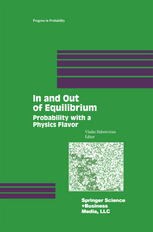

Most ebook files are in PDF format, so you can easily read them using various software such as Foxit Reader or directly on the Google Chrome browser.
Some ebook files are released by publishers in other formats such as .awz, .mobi, .epub, .fb2, etc. You may need to install specific software to read these formats on mobile/PC, such as Calibre.
Please read the tutorial at this link: https://ebookbell.com/faq
We offer FREE conversion to the popular formats you request; however, this may take some time. Therefore, right after payment, please email us, and we will try to provide the service as quickly as possible.
For some exceptional file formats or broken links (if any), please refrain from opening any disputes. Instead, email us first, and we will try to assist within a maximum of 6 hours.
EbookBell Team

4.8
24 reviewsFor more than two decades percolation theory, random walks, interacting parti cle systems and topics related to statistical mechanics have experienced inten sive growth. In the last several years, especially remarkable progress has been made in a number of directions, such as: Wulff constructions above two dimen sions for percolation, Potts and Ising models, classification of random walks in random environments, better understanding of fluctuations in two dimen sional growth processes, the introduction and remarkable uses of the Stochastic Loewner Equation, the rigorous derivation of exact intersection exponents for planar Brownian motion, and finally, the proof of conformal invariance for crit ical percolation scaling limits on the triangular lattice. It was thus a fortuitous time to bring together researchers, including many personally responsible for these advances, in the framework of the IVth Brazilian School of Probability, held at Mambucaba on August 14-19,2000. This School, first envisioned and organized by IMPA's probability group in 1997, has since developed into an annual meeting with an almost constant format: it usually offers three advanced courses delivered by prominent scientists, combined with a high-level conference. This volume contains invited articles associated with that meeting, and we hope it will provide the reader with an accurate impression regarding the current state of affairs in these important fields of probability theory.